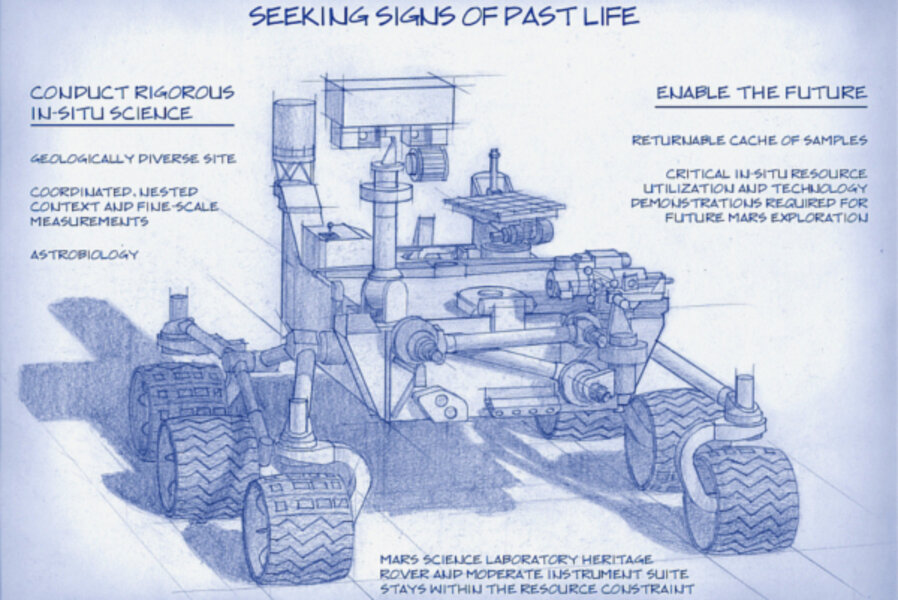Mars 2020: NASA's going bold – on a budget
Loading...
For many, the pinnacle of Mars research would be sending human scientists to explore the surface, gather specimens, and study them with high-tech instruments, either there or back here on Earth.
That's what we did with the Apollo missions, and it transformed our understanding of the moon's surface. NASA's vision for Mars, announced Tuesday at a press conference at NASA's headquarters in D.C., isn't quite that grand, but it's surprisingly close – and they're doing it on a budget.
"One of the very biggest questions for all of humankind is, Are we alone?" asks Lindy Elkins-Tanton, a planetary scientist on the Mars 2020 science team. "And that is the question we are hoping to make really big advances with in this Mars 2020 mission."
Here's the good news for Red Planet enthusiasts: In 2020, NASA will send a near-clone of Curiosity, the wildly successful robot currently exploring Mars, to some really juicy terrain where life may once have flourished.
The even better news, if you're rooting to send people there: The mission will test out equipment that humans will need on Mars, a concrete step toward President Obama's stated goal of having humans on Mars by the mid-2030s.
While exploring, the Mars 2020 rover will stockpile the most interesting specimens it finds and keep them on ice for a future sample-return mission.
"Those samples are going to have an enormous impact on our understanding of planetary science," says Jack Mustard, the leader of the rover's science definition team.
NASA won't say exactly when or how those samples will be transported to Earth, prompting speculation that the rocks will wait for those human geologists. It's possible that they'll be flown back by a future unmanned mission, although the US has never accomplished a robotic sample-return mission. Soviet scientists did it three times in the 1970s, bringing moon rocks and dust back to Moscow in 1970, 1972, and 1976.
Don't worry that the specimens will die while waiting for their ticket to Earth: the rover isn't looking for anything currently alive. After all, odds are good that anything living on Mars right now would be deep underground, and we don't even begin to know where to look. (Wandering the planet and shouting, "Here, little bacteria! Here, little bacteria!" seems like a waste.)
Instead, the rover will look for ancient life. As NASA's John Grunsfeld said during Tuesday's press conference, "We know it had a habitable environment," but we still haven't found proof to answer the question, "Did Mars ever have life?" The rover will explore areas that used to be warm and wet and hospitable, even if they're cold and dry and barren today, and look for evidence of once-living creatures.
But here's the bad news: The budget for Mars 2020 is about $1 billion less than the budget for Curiosity, coming in at $1.5 billion. That has prompted some cost-saving measures, like recycling Curiosity's design even using some of its some spare parts. The scientific instruments will be different, but the chassis and the entire landing system – including the nifty sky crane – can be rebuilt with little new engineering or research.
Like a new model year of the same car, NASA has upgraded the dashboard and added heated seats, but the engine, drive shaft, and wheels are essentially the same. Also, as Curiosity has been such a roaring success, NASA's version of car insurance (funding to be held in reserve in case of emergency) is cheaper, too.
The team will tweak the landing system's design to improve the landing site precision and accuracy, says Dr. Mustard, who teaches at Brown University. He points out that NASA engineers placed Curiosity "exactly where they wanted to," but the rover still required months of trundling along at its slower-than-walking pace to get to its target, Mount Sharp. "With the new technologies we're talking about," he says, "they could land right at the base of Mount Sharp – within spitting distance, instead of an 8-month drive away."
"NASA is not just about science questions," says Dr. Elkins-Tanton. It's about "inspiring a whole new global generation to think big, to aspire, and to reach out."








